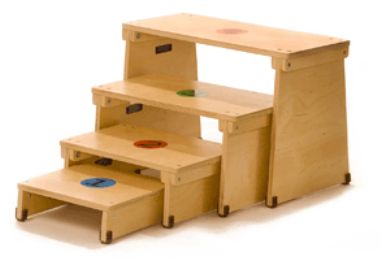
Pediatric gross motor skills development is a critical developmental aspect of the first several years of life. Provide many opportunities for physical exploration of their environment, to help children successfully develop. This is even more important for special needs children.
Rehabmart carries a large assortment of pediatric gross motor development devices from noted vendors such as Sammons Preston, TFH, Fabrication Enterprises, Southpaw Enterprises, R.E.A.L. Design, Kaye Products Inc., Experia-USA, Enabling Devices, Kids Fit and others.








What are Gross Motor Skills and How do they Develop?
Gross motor skills are movements that involve the large muscles of the body, in the arms, legs and torso (or core). These muscles enable functions such as walking, maintaining balance, kicking, jumping, lifting, sitting upright, developing coordination, reaching for objects and throwing a ball.
Gross motor skills develop as children grow and explore their environments. For example, usually at the age of one month infants can lift their heads for a short time while on their tummies; by six months, they can generally roll over from back to tummy and vice versa. And so on for many years as a child’s abilities, sense of balance and independence grow.
The rate at which motor skills develop varies, and is determined by a combination of controllable factors (the environment into which they are born) and uncontrollable factors (such as genetic or inherited traits, and congenital learning disabilities). Muscle tone and strength also factor in.
Some Children Need Additional Help Developing Motor Skills.
Hypotonia (low muscle tone) is a characteristic of several disabling conditions such as Down syndrome, central nervous system disorders, genetic or muscle disorders. Children with developmental delays, neurological problems, or disabilities that affect movement may benefit from physical therapy to help with gross motor skills. A child’s gross motor abilities share connections with other functions requiring physical coordination, so ensuring your child has the best opportunity for gross motor skill development will positively affect other developmental stages.
For example, a student’s ability to write (a fine motor skill) will be affected by his ability to maintain upper body support (a gross motor skill). Similar examples include the activities of sitting erect in an alert position to watch classroom activity, and writing on a blackboard.
Help is Available Through the Rehabmart Selection of Gross Motor Development Tools.
Assistive technologies and devices to help with gross motor development abound. More than sixty developmental tools focused on pediatric gross motor development are available today from Rehabmart. Each focuses on one or more of the following goals:
Rhythmic movement experience - Develop tolerance for movement
Improve flexion development of key joints
Reduce gravitational insecurity
Head control, balance or trunk control when seated
Body strengthening
Bilateral activities
Gross motor functions
Enhance body awareness, body schema, motor planning and bilateral coordination
Combine gross motor movement with cause-and-effect understanding
Climbing skills
Moving independently
Balancing
Walking (including tools that provide auditory feedback to kicking, heel strike, and toe off)
Transition from sitting to standing
Improve upper extremity range of motion, trunk strength and cardiovascular fitness
Eye-hand coordination and motor planning skills, dexterity, spatial relations, manipulative skills
Estimate distances and heights
Color recognition and auditory stimulation
These devices are suitable for use in hospitals, rehabilitation clinics, classrooms, and for personal use at home. While most of the devices are targeted to children of varying ages, there are also age-appropriate choices for rehabilitation and adult activities in clinics, rehabilitation facilities and nursing homes.
Should you need assistance choosing the right product for your needs, do not hesitate to contact us. We’d be happy to help.
Hulet Smith, OT
Rehabmart Co-Founder & CEO
nrb